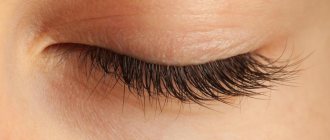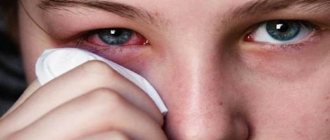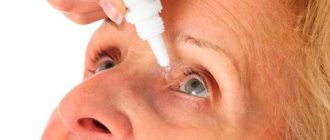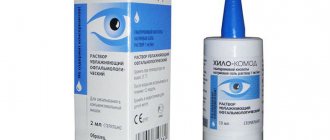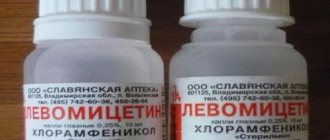Viral infections are one of the most common causes of inflammatory eye diseases, including conjunctivitis, keratitis, blepharitis, and uveitis. Most often they are caused by an adenovirus; less common are infections with herpes, picarnovirus, enterovirus and other pathogenic microorganisms. Treatment of such diseases is carried out with special antiviral drugs, which are most often produced in the form of drops. What drops are used in the treatment of viral eye diseases, and how to use them correctly?
Antiviral eye drops
Operating principle
- 6.1 Video - How to treat conjunctivitis?
All human infectious diseases, that is, those caused by the activity of pathogenic microorganisms, can be divided into viral and bacterial. There is a significant difference between viruses and bacteria, so the methods of treating diseases also differ from each other. For bacterial infections, drugs are used that destroy foreign agents, and the therapy for viral diseases is to create favorable conditions for the body to independently fight foreign agents.
Infectious diseases are viral and bacterial
The mechanism of action of antiviral drops on pathogens is based on a special protein called interferon, which fights viruses that cause diseases. It stops the proliferation of pathogenic microorganisms and blocks their further activity. Some drugs promote the production of their own interferon in tissues, while others contain this protein in finished form. A separate group includes virucidal drugs, which are most often used to treat diseases caused by the herpes virus. They contain active components that stop DNA synthesis in the cells of pathogenic microorganisms, as a result of which they quickly die.
Mechanism of action of antiviral drugs
Table. Groups of drugs.
| Group of drugs | Features of the impact | Drugs |
| Virucidal | Destroy viruses that cause the pathological process | Oftan go, Ganciclovir, Idoxuridine, Florenal |
| Interferons | Analogues of interferons, which are found in the human body and fight foreign agents | Oftalmoferon, Okoferon |
| Immunomodulators | Promote the production of its own interferon, increase local immunity, thanks to which the body independently copes with a viral infection | Aktipol, Poludan, Adgelon |
Classification of immunomodulators
Attention: most antibacterial drugs are ineffective against viruses, so therapy should be selected only after identifying the causative agent of the disease.
Antibacterial drops for adults
Medications to help cope with eye infections can be used for adults and children. Adult drops differ in composition, dosage and properties. The most effective today are recognized as:
- Albucid
. Inexpensive, proven antibacterial agent over the years. Stops the proliferation of pathogenic microorganisms and has a detrimental effect on the vital processes of bacteria. Prescribed 1-2 drops in each eye. Frequency of application 3-6 times a day. - Oftadek
. An effective antibacterial and antifungal agent. It does not provoke addiction, so it can be used for long-term therapy. The frequency of use and dose depend on the cause of the disease. - Levomycetin
. Destroys the walls of bacterial cells, stopping their vital activity, and negatively affects the reproduction processes. The drug is especially popular because it is the cheapest (10-20 rubles). - Azidrop
. Broad-spectrum antibacterial drug. It is prescribed for both treatment and prevention of infectious diseases. Apply once a day for 5-7 days. Not recommended for long-term use. - Normax
. It affects only the processes of bacterial reproduction, it does not affect the microorganisms themselves. Subsequently, the infection goes away on its own from the body. Place 3-4 drops in each eye up to five times a day.
To treat eye infections of unknown etiology, it is necessary to use broad-spectrum medications. During treatment with antibacterial drugs, it is necessary to monitor your well-being. If undesirable effects occur, you must stop using the product and contact a medical facility to replace the drops.
Indications and contraindications
Indications for the use of antiviral eye drops include diseases caused by any viruses:
- conjunctivitis;
- keratoconjunctivitis;
- keratitis;
- iridocyclitis;
- uveitis;
- optic neuritis.
What does conjunctivitis look like?
Contraindications to use depend on the characteristics of the particular drug, but most often these are individual hypersensitivity to individual components of the drug, disorders of the hematopoietic system, severe dysfunction of the kidneys, liver, cardiovascular system, mental disorders and central nervous system. Some drops are prohibited for use during pregnancy and childhood, but if the expected benefit outweighs the possible risk to human health, the drugs can be used under the supervision of a doctor.
General principles of treatment of all types of conjunctivitis
Side effects
Antiviral drops for the treatment of eye diseases do not have a systemic effect on the body, but can cause adverse reactions from various organs and systems:
- drowsiness and apathy;
- burning and discomfort in the eyes, itching, redness of the conjunctiva and eyelids;
- deterioration of general health, decreased performance;
- headaches and dizziness;
- fever, chills, body aches;
- increased sweating.
Redness of the eyes
Attention: if serious side effects develop, you should immediately stop using the drops, rinse your eyes with warm water, and then consult a doctor to change the product.
Symptoms of viral eye diseases
You can suspect the development of a viral eye infection by:
- lacrimation;
- soreness;
- photophobia;
- hyperemia (redness) of the conjunctiva;
- the appearance of blisters and ulcers on the eyelids;
- foreign body sensation;
- swelling of the eyelids, etc.
Herpes zoster ophthalmicus may begin with an unpleasant tingling sensation on the tip of the nose. Subsequently, a rash similar to chickenpox may appear on the skin of the forehead. At the same time, typical ophthalmological symptoms and signs of intoxication occur (weakness, weakness, fever).
The appearance of these symptoms is a reason for an early visit to an ophthalmologist. You should not deal with the disease on your own, for example, by rinsing with medicines from your home medicine cabinet or by using alternative medicine. Only a doctor can make the correct diagnosis and prescribe treatment.
Photo: 12019 / Pixabay.com
Popular drugs
The range of antiviral eye drops in pharmacies is quite wide, so choosing a drug will not be difficult, but before treatment you need to consult a doctor and also carefully read the instructions.
Levomycetin
Oftan I'm coming
Drops for the treatment of viral diseases in ophthalmology, which act directly on the structure of pathogenic microorganisms, due to which they quickly die. The active ingredient of the drug is active against various viruses, but it is preferable to use it when infected with herpes. The main disadvantage is the development of side effects, including burning in the eyes, increased tearing and photosensitivity; corneal clouding, development of blepharitis, and decreased visual function are rarely observed.
Oftan I'm coming
Ganciclovir (Virgan, Zirgan)
A drug that effectively fights herpes simplex virus, Epstein-Barr and citalomegavirus, the main indication for use is keratitis of herpetic origin. The drops are well tolerated by the body, rarely cause side effects, and are approved for use in childhood.
Virgan
Idoxuridine
An antiviral agent that is active against herpes simplex virus, Epstein-Barr virus, citalomegaviruses, orthoviruses, is used for the treatment and prevention of herpetic keratitis and conjunctivitis. Not used during pregnancy, advanced forms of keratitis, can cause headaches, sometimes allergic reactions on the eyelids and eye tissues, clouding of the cornea.
Idoxuridine
Important: drugs that affect the DNA of pathogenic microorganisms slow down metabolic and regenerative processes in eye tissues, so they are best used in combination with vitamin therapy and means to improve metabolism.
Oftalmoferon
One of the most effective drugs, which has not only antiviral activity, but also an analgesic and anti-inflammatory effect, which quickly eliminates the symptoms of inflammatory diseases. It does not affect metabolic processes in tissues, does not slow down regenerative processes in tissues and does not impair visual function. In rare cases, side effects are possible due to increased production of interferons in the body - fever, chills, pain in muscles and joints.
Oftalmoferon
Poludan
Drops are prescribed for diseases caused by the herpes virus and adenovirus, but can also be used in other cases. Contains substances that promote the production of protective cells (T-killers and cytokines), increases local immunity and quickly improves the condition of patients. After using the drops, you may experience increased blood pressure, nausea, headaches and joint pain, and in rare cases, impaired hematopoietic function. It is usually prescribed to adult patients, and use in childhood requires strict medical supervision.
Poludan
Aktipol
A new generation medicine that has antiviral, antioxidant and radioprotective effects, that is, in addition to destroying viruses, it protects the eyes from radiation and the influence of free radicals. It is usually used for the treatment of pathological processes caused by herpes and adenovirus, as well as for increased eye fatigue, dry eye syndrome, and during the recovery period after injuries and tissue burns. It has a minimal number of side effects and, if necessary, can be used during pregnancy and lactation. The drug is incompatible with antibiotics based on sulfacyl sodium and is strictly contraindicated for people suffering from autoimmune disorders.
Aktipol
Adgelon
The drug does not have a direct antiviral effect, but is able to inhibit the activity of pathogenic microorganisms and activate regenerative processes, due to which the healing process is significantly accelerated. Indications include keratitis of various etiologies (herpetic, adenoviral), burns and penetrating eye injuries. The product increases local immunity, is highly effective and has virtually no contraindications (can be used even in people with a tendency to allergic reactions).
Adgelon
Okoferon
Powder for preparing a solution, which is sold complete with a special solvent substance. It is considered one of the safest and most accessible means for the treatment of viral eye lesions, including keratitis, keratoconjunctivitis, keratouveitis and other diseases. The only contraindication is individual hypersensitivity to the components of the drug. In rare cases, side effects may develop, including burning and discomfort in the eyes, short-term blurred vision, and allergic reactions.
Okoferon
Attention: when using any antiviral eye drops, it is important to follow the dosage recommended by the doctor - if the dose is reduced, the therapeutic effect is significantly reduced, and if the dose is increased, adverse reactions may develop.
Antiviral drops for children
Children's antiviral eye drops
Viral eye diseases are more common in childhood than in adults, and the symptoms are more pronounced and are often accompanied by a deterioration in general health, fever, and headaches. To treat inflammatory processes in children, it is best to use drugs that promote the production of interferon in the body and do not cause side effects - Ophthalmoferon, Poludan, Aktipol , but before use you should definitely consult a specialist.
Indications for use
Antiviral eye drops are prescribed in the presence of an inflammatory process of viral origin, when the following diseases are diagnosed:
- conjunctivitis;
- keratitis;
- uveitis;
- keratoconjunctivitis;
- iridocyclitis.
The eye can be affected by adenoviruses, enteroviruses, cytomegalovirus, picornavirus and herpes viruses. In such conditions, antibacterial agents will not help. For treatment to be adequate and effective, it is imperative to consult an ophthalmologist to establish an accurate diagnosis.
Rules for using antiviral drops
How to instill eye drops
Before using antiviral eye drops, you must check the expiration date of the drug - using expired drops is strictly not recommended. Wash your hands well and, if necessary, wipe your eyes with an antiseptic solution or chamomile decoction, removing discharge and crusts. Next, you need to slightly pull down the lower eyelid, place the doctor-recommended number of drops into the eye, and then blink a little so that the substance is well distributed over the surface of the eye. Eye drops are usually stored in the refrigerator, and before use the bottle should be slightly warmed between the palms.
The frequency of the procedure and the duration of treatment depend on the clinical characteristics of the disease and are determined by an ophthalmologist. If the effect of using drops is absent for 2-3 days, you should consult a doctor and replace the drug.
Burial rules
Antiviral eye medications are highly effective and can quickly eliminate the cause of diseases along with the symptoms, but independent use of the drugs is strictly prohibited. At the first manifestations of infection, you should contact a specialist who will select the optimal drug taking into account the age, health status and characteristics of the patient’s body.



